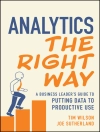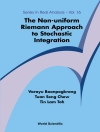Features a practical approach to the analysis of biomedical data via mathematical methods and provides a MATLAB® toolbox for the collection, visualization, and evaluation of experimental and real-life data
Applied Mathematics for the Analysis of Biomedical Data: Models, Methods, and MATLAB® presents a practical approach to the task that biological scientists face when analyzing data. The primary focus is on the application of mathematical models and scientific computing methods to provide insight into the behavior of biological systems. The author draws upon his experience in academia, industry, and government-sponsored research as well as his expertise in MATLAB to produce a suite of computer programs with applications in epidemiology, machine learning, and biostatistics. These models are derived from real-world data and concerns. Among the topics included are the spread of infectious disease (HIV/AIDS) through a population, statistical pattern recognition methods to determine the presence of disease in a diagnostic sample, and the fundamentals of hypothesis testing.
In addition, the author uses his professional experiences to present unique case studies whose analyses provide detailed insights into biological systems and the problems inherent in their examination. The book contains a well-developed and tested set of MATLAB functions that act as a general toolbox for practitioners of quantitative biology and biostatistics. This combination of MATLAB functions and practical tips amplifies the book’s technical merit and value to industry professionals.
Through numerous examples and sample code blocks, the book provides readers with illustrations of MATLAB programming. Moreover, the associated toolbox permits readers to engage in the process of data analysis without needing to delve deeply into the mathematical theory. This gives an accessible view of the material for readers with varied backgrounds. As a result, the book provides a streamlined framework for the development of mathematical models, algorithms, and the corresponding computer code.
In addition, the book features:
* Real-world computational procedures that can be readily applied to similar problems without the need for keen mathematical acumen
* Clear delineation of topics to accelerate access to data analysis
* Access to a book companion website containing the MATLAB toolbox created for this book, as well as a Solutions Manual with solutions to selected exercises
Applied Mathematics for the Analysis of Biomedical Data: Models, Methods, and MATLAB® is an excellent textbook for students in mathematics, biostatistics, the life and social sciences, and quantitative, computational, and mathematical biology. This book is also an ideal reference for industrial scientists, biostatisticians, product development scientists, and practitioners who use mathematical models of biological systems in biomedical research, medical device development, and pharmaceutical submissions.
قائمة المحتويات
Preface xi
Acknowledgements xiii
About the Companion Website xv
Introduction xvii
1 Data 1
1.1 Data Visualization 1
1.2 Data Transformations 3
1.3 Data Filtering 7
1.4 Data Clustering 17
1.5 Data Quality and Data Cleaning 25
References 28
2 Some Examples 29
2.1 Glucose-Insulin Interaction 30
2.2 Transition from HIV to AIDS 33
2.3 Real-Time Polymerase Chain Reaction 37
References 45
Further Reading 45
3 SEIR Models 47
3.1 Practical Applications of SEIR Models 50
References 88
Further Reading 90
4 Statistical Pattern Recognition and Classification 93
4.1 Measurements and Data Classes 94
4.2 Data Preparation Normalization and Weighting Matrix 98
4.3 Principal Components 104
4.4 Discriminant Analysis 107
4.5 Regularized Discriminant Analysis and Classification 112
4.6 Minimum Bayes Score Maximum Likelihood and Minimum Bayes Risk 116
4.7 The Confusion Matrix Receiver-Operator Characteristic Curves and Assessment Metrics 122
4.8 An Example 127
4.9 Nonlinear Methods 131
References 139
Further Reading 140
5 Biostatistics and Hypothesis Testing 141
5.1 Hypothesis Testing Framework 142
5.2 Test of Means 157
5.3 Tests of Proportions 179
5.4 Tests of Variances 212
5.5 Other Hypothesis Tests 232
References 268
Further Reading 270
6 Clustered Data and Analysis of Variance 271
6.1 Clustered Matched-Pair Data and Non-Inferiority 273
6.2 Clustered Data Assessment Metrics and Diagnostic Likelihood Ratios 278
6.3 Relative Diagnostic Likelihood Ratios 286
6.4 Analysis of Variance for Clustered Data 291
6.5 Examples for Anova 300
6.6 Bootstrapping and Confidence Intervals 314
References 316
Further Reading 316
Appendix: Mathematical Matters 317
Glossary of MATLAB Functions 335
Index 407
عن المؤلف
PETER J. COSTA, Ph D, is Senior Applied Mathematician at Hologic Incorporated in Marlborough, MA. Dr. Costa is the co-creator of MATLAB’s Symbolic Math Toolbox. He has developed mathematical models for the spread of HIV, the outbreak of AIDS, the transmission of an infectious respiratory disease throughout a population, and the diagnosis of cervical cancer. His research interests include scientific computing and mathematical biology. He received a Ph D in Applied Mathematics from the University of Massachusetts at Amherst.












